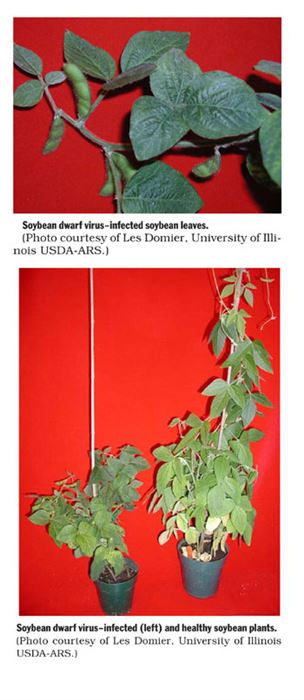Soybean Puckering And Dwarfing
URBANA, ILL.
A sample recently submitted to the University of Illinois Plant Clinic presented confusing symptoms. New leaves were puckered, older leaves were just a bit off-color; the sample plant was not stunted, though the client reported stunted plants in that area of the field. Puckering can be attributed to several causes, including herbicide drift or carryover, heat, and leafhoppers, but none of these possibilities seemed to fit the entire picture. We had the sample tested for virus infection, and it was positive for a malady you may be unfamiliar with: soybean dwarf virus (SbDV).

In Japan, soybean dwarf virus is a serious economic disease. Symptoms are dwarfing and reduced seed set of the soybean plant, which is severe if the plant is infected in the seedling stage. Unlike other plants in the field, our sample was not severely dwarfed, most likely because it was infected later in the season.
University of Illinois USDA-ARS virologist Dr. Les Domier first reported SbDV disease in Illinois in the 2006 soybean crop, and he continues research on the issue. Before then, SbDV was known to be endemic in red and white clover but had only been detected in soybean in Wisconsin and Virginia.
In the forage legumes, the virus is persistently transmitted by several colonizing aphid species. Recent research on SbDV addressed whether soybean aphid, a soybean-colonizing aphid, would be a good vector for SbDV and, if so, whether the incidence would increase in our fields. A multistate study looking at transmission of SbDV by various aphids has found that soybean aphid is actually an inefficient vector of the virus. However, the authors conclude that “although transmission of SbDV by the soybean aphid is very inefficient, the large soybean aphid populations that develop on soybean may have epidemiological potential to produce serious SbDV-induced yield losses” (apsjournals.apsnet.org/doi/pdf/10.1094/PDIS-10-10-0726).
What can be done about soybean dwarf virus? We have no current recommendations for control, but work continues. Dr. Domier notes that resistance has not been found in soybean to SbDV, although some cultivars show only mild symptoms when infected. SbDV is another disease to keep an eye out for in soybean fields as you scout. Diseases can and do change in their distribution more frequently than we like. It may surprise you to know that SbDV is actually more common in Illinois than our old friend soybean mosaic virus (SMV). Δ
DR. SUZANNE BISSONNETTE: Plant Diagnostic Clinic and IPM coordinator, University of Illinois